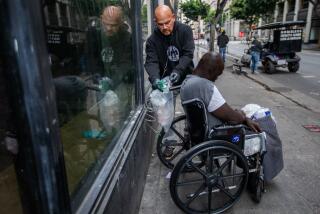Detective Sees ID Bracelets as Vital in Giving Aid to Missing
- Share via
Detective Doug Haskin has spent the better part of the decade finding missing persons and returning people whose memories are impaired to the those who care for them.
Sitting behind his desk in the Missing Persons Unit at the Los Angeles Police Department headquarters, the burly veteran investigator described a scenario he confronts daily.
“It begins like this,” he said, leaning forward and taking a long drag on a cigarette. “An individual who can’t even remember his name walks away from a room-and-board facility. He’s wandering around the streets. Citizens take him in. They call the police.
“Officers get there, but he can’t remember who he is or where he lives. The officers notify us and then take him to the station. They’ll wait there while we try to link him to a report of a missing person. The officers wait, but they have to get back on the streets. If we can’t help, they only have one alternative--take him to a county hospital.”
The memory-impaired person may remain at the hospital for days, weeks or even months as social workers and detectives try to determine who he is and where he lives. Haskins said one man spent nearly four months in a hospital before he was returned to his home, just a few blocks from where police picked him up.
For each day that an otherwise healthy person occupies a county hospital bed, taxpayers shell out a minimum of $1,000, including the costs of social workers and detectives.
Last year, Haskin and other detectives wrote up 3,170 missing persons reports. Of those, 1,827--or 58%--were for people described as being in poor mental health.
“The 58% we wrote reports on--and that doesn’t include the hundreds of others who were lost and returned before we had a chance to write a report--were schizos, Alzheimer’s disease, coke heads, retarded, people in and out of mental hospitals . . . people with poor memories,” Haskin said.
Haskin’s office walls are covered with photos of John Does and Jane Does, police jargon for unidentified men and woman. Some of the Does are dead, their photos taken in a morgue.
He envisions a scenario that could make his life, and theirs, a lot simpler.
“Picture this,” he said. “A person walks away. A citizen takes him in and calls us. He’s wearing a Medic Alert bracelet. We ask for the personal identification number on the bracelet and send a (police) unit out. As the officers are en route, we call Medic Alert and give them the ID number. They put the number into a database and come up with the person’s name, what medications he’s on, where he lives, information on who to call in case of emergency--everything we want to know about this person.
“By the time officers arrive and pick him up, we can tell them who they got and where he lives. Within minutes he’s home and the unit is free to return to the street.”
Giving memory-impaired people bracelets that can help authorities quickly identify them is an idea whose time has come, Haskin said.
And although such a program has not been established in Los Angeles, a similar program for Alzheimer’s patients has been in operation in San Diego County for a year.
“We’re very pleased with it,” said Judy Neubauer, director of operations for Alzheimer’s Family Center. “It’s very good for anyone who may lose consciousness.”
The San Diego center’s director, Joy Glenner, saw a need to do more to help lost Alzheimer’s patients when she learned police were putting some of them in jail after mistaking them for drunks.
Glenner contacted Medic Alert Foundation International, the only 24-hour international service providing authorities with crucial information on individuals wearing medical-alert bracelets and pendants.
What followed was Medic Alert’s creation of Links to Life, a program specifically designed to assist authorities with Alzheimer’s patients who wander off. The start-up cost to each community is $10,000--a sum quickly repaid by the savings incurred.
The only other costs to the community are the $25 charge for each lifetime membership. In San Diego, county supervisors were so taken by the program they donated their own money to create a fund to pay the $25 fee for Alzheimer’s patients who can’t afford it.
“In addition to helping officials return a lost Alzheimer’s patient,” said Rich Haggart, director of Medic Alert’s Links-to-Life operation, “when a person wearing a Medic Alert is rushed to a hospital after collapsing or suffering some other emergency, the doctor at the hospital is able to learn from us exactly what type of medication the patient’s on, who his doctor or doctors (are), and who to contact in case of emergency.”
“It will have other information as well that may be helpful to the doctor,” Haggart continued. “If, for example, the patient recently underwent a coronary bypass, medical personnel will be warned not to apply cardiopulmonary resuscitation directly to the heart because the pressure on his chest would kill him.”
Haggart says the Links-to-Life program has now been set up in eight communities and will begin in Orange County this month.
For Haskin, a strong proponent of bracelets, the sooner they spread to Los Angeles the better.
‘It begins like this. An individual who can’t even remember his name walks away from a room-and-board facility. He’s wandering around the streets. Citizens take him in. They call the police.’
Detective Doug Haskin
LAPD Missing Persons Unit
More to Read
Sign up for Essential California
The most important California stories and recommendations in your inbox every morning.
You may occasionally receive promotional content from the Los Angeles Times.













